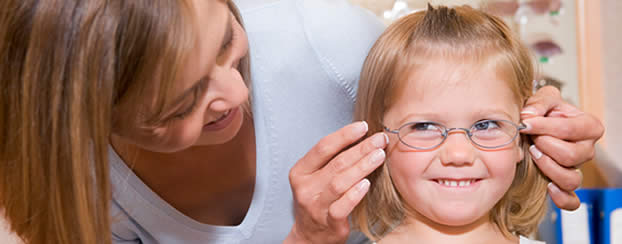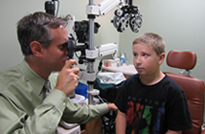Pediatric Ophthalmology

Dr. Steinberg recommends a first eye exam around age three and a half. Sometimes a "lazy eye" problem can be detected at this early age even when the eyes are not crossed. Pediatric ophthalmology and the treatment of eye muscle problems has always been a focus of his practice. As a father, he understands the special needs of children with eye problems and patiently attends to them.
About Pediatric Opthalmology
Clear vision and healthy eyes are important not only to a child's overall health and well-being, but also directly related to their academic performance in school. While vision screenings given at a child's school each year may identify children who are at risk for problems with their vision, vision screenings do not test the overall health of the child's eyes. A professional eye examination, performed by a certified eye doctor, tests vision while also evaluating the child's eyes for more serious conditions and diseases.
Common Pediatric Eye Conditions
In addition to detecting vision problems, our eye examinations check for common childhood conditions such as:
- Amblyopia, or lazy eye
- Strabismus, or crossed eyes
- Glaucoma
- Cataracts
- Astigmatism
- Amblyopia
- Nearsightedness, or myopia
- Farsightedness, or hyperopia
These conditions are often present at birth as a result of genetic factors, and should be treated early to reduce the risk of complications. Treatment may include glasses to improve focus or eye exercises to correct improper vision habits.
The Pediatric Eye Examination
 A comprehensive eye examination is essential in the diagnosis and treatment of vision problems, injury and disease. Early detection allows treatment to begin before the child experiences difficulties in school due to poor vision, or before any permanent damage occurs.
A comprehensive eye examination is essential in the diagnosis and treatment of vision problems, injury and disease. Early detection allows treatment to begin before the child experiences difficulties in school due to poor vision, or before any permanent damage occurs.
Children's eye examinations usually include tests for the following:
- Visual acuity
- Focusing skills
- Near vision
- Distance vision
- Strabismus
- Amblyopia
- Color blindness
- Slit-lamp examination
These vision aspects are assessed through traditional eye charts, including charts that use special symbols instead of letters for young children; retinoscopy, which shines a light into the eye to examine the retina; and random dot stereopsis, which uses dot patterns to detect any differences between the two eyes.
Older children may undergo testing similar to those tests used for adults, including:
- A visual field test
- Dilation
- Slit-lamp examination
- Cover test
- Retinoscopy
- Refraction
After a Pediatric Eye Examination
After the exam and an accurate diagnosis a treatment plan will be developed that may include:
- A prescription for eyeglasses
- Medication
- Surgery
